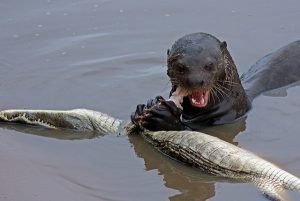
The giant otter is not just any otter; it’s the largest member of the weasel family, measuring up to 6 feet long and weighing up to 75 pounds. With its sleek body and webbed feet, this animal is a master of the waterways, making it a savvy hunter. Let’s dive into what they eat, how they catch their food, and why these strategies are important for their survival.
Diet: What Do Giant Otters Eat?
Giant otters are known as opportunistic carnivores, meaning their menu can change based on availability. But, more often than not, their primary diet consists of a variety of freshwater fish. They’re particularly fond of fish species like the pacu, catfish, and dorado. It’s like having a well-stocked fish market right in their backyard!
Here’s the thing: not only do giant otters eat fish, but they also enjoy crustaceans, small mammals, and even birds. They have a remarkable ability to dive deep underwater, which allows them to hunt effectively. While fishing, they can stay submerged for up to 5 minutes, using their keen eyesight and excellent sense of hearing to spot prey.
Interestingly, giant otters often hunt in groups, called *rafts*. These rafts usually consist of 3 to 20 individuals, working together to catch fish. This social behavior not only enhances their hunting success but also strengthens their bonds with one another. It’s kind of like a team of friends going out for a seafood feast!
Hunting Strategies: How Do Giant Otters Catch Their Prey?
Now that you know what they eat, let’s explore how they actually catch their food. Giant otters are very strategic hunters. They often rely on a method called foraging, which means they actively search for and capture their prey.
One of their most effective hunting strategies is using their speed and agility underwater. They can swim at impressive speeds of up to 20 miles per hour. By swiftly darting through the water, they can surprise their prey. Imagine a sleek rocket zooming through the river, with its target barely having a chance to react.
Another fascinating aspect of their hunting tactics is their ability to work together. When hunting in a group, one otter might flush out a fish while others wait to ambush it. This teamwork allows them to catch larger prey that may be more difficult to tackle alone. It’s like a well-rehearsed dance, with each otter knowing its role.
Using Tools: Clever Otters
Did you know that giant otters are not just intelligent hunters; they can also use tools? Some otters have been observed using rocks or other hard objects to crack open the shells of crustaceans. This innovative behavior highlights their problem-solving skills and adaptability in the wild.
Using tools is a great example of how these otters can modify their hunting strategies based on the challenges they face. If they can’t catch fish easily, they’ll switch to a different food source, showcasing their versatility. Just think of them as crafty little chefs, ready to whip up whatever dish will help them thrive.
Impact of Diet on Habitat
The diet of giant otters plays a crucial role in their habitat and ecosystem. These animals are often found in Amazonian rivers, lakes, and streams, where they can access a rich supply of fish. Their hunting practices help control fish populations, ensuring a balanced ecosystem.
However, the availability of food is influenced by various factors, including pollution, habitat destruction, and climate change. When their diet is compromised, it can have a ripple effect on the entire ecosystem. It’s a reminder of how interconnected nature is, showing that protecting one species can help safeguard many others.
Challenges in the Wild: Threats to Giant Otters
Sadly, giant otters face several challenges that can impact their hunting and feeding habits. Habitat destruction is a significant threat, as rivers are dammed or polluted by human activity. When their homes are altered, it can lead to reduced fish populations, making it harder for these otters to find food.
Additionally, giant otters are often hunted for their fur or seen as competitors by local fishermen, which further complicates their survival. Conservation efforts are critical to ensure that these animals can continue to thrive in their natural habitats. By protecting river ecosystems and promoting sustainable fishing practices, we can help safeguard the future of giant otters.
Conservation Efforts: Protecting the Giant Otter
Speaking of conservation, there are various initiatives in place to help giant otters. Organizations work to rehabilitate their habitats, promote eco-tourism, and educate local communities about the importance of preserving these magnificent creatures.
By raising awareness and involving local people in conservation efforts, we can create a brighter future for giant otters. It’s not just about saving one species; it’s about enriching the entire ecosystem and ensuring that future generations can enjoy watching these playful otters thrive in the wild.
In closing, the diet and hunting strategies of the giant otter are not only fascinating but also essential for understanding the balance of their ecosystems. Their adaptability, teamwork, and clever hunting tactics make them a remarkable part of nature’s web. So, next time you see an otter, remember that there’s a lot more going on beneath the surface than just playfulness—these creatures are master hunters and caretakers of their environment!
